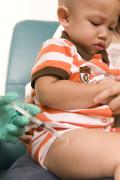By Kara Stephens
Current Status: Public Health Nemesis
If you’ve been reading the news the past few weeks, you may have heard about the recent outbreak of pertussis that has reached epidemic levels in Washington. There have been 2,092 cases reported statewide through June 5, 2012, compared to 164 reported cases in 2011 during the same time period. Other states are also reporting increased levels or outbreaks of pertussis. Outbreaks reported in schools and communities as well as the beginning of summer camp season highlight the importance of public awareness. View the Pertussis Disease Villain’s rap sheet below to find out more about this public health nemesis.
Real name: Pertussis
Known aliases: Bordetella pertussis (the bacteria that causes pertussis illness); whooping cough (for the “whoop” sound of someone gasping for air after a coughing spell).
Microbe type: Bacterium
Pertussis, also known as whooping cough, is a respiratory disease that can be fatal, especially for infants. At first, signs and symptoms of this tricky pretender might seem like a common cold — runny nose, no or low-grade fever, and cough. That’s stage 1, when pertussis is just warming up. After a week or two, pertussis infection delivers its cruel surprise — uncontrollable, violent coughing spells. Severe coughing attacks often leave victims gasping for air — often described as a “whooping” sound. However, if you have been vaccinated, the infection is usually less severe and often the “whoop” is not present.
In infants, the cough can be minimal or not even there. Infants may have a symptom known as “apnea,” a long pause in the breathing pattern.
Preferred Method of Attack
Pertussis is primarily an “air attacker,” flying through the air looking for its next victim, when an infected person coughs or sneezes. Many infants who get pertussis are infected by older siblings, parents or caregivers who might not even know they have the disease Pertussis loves crowded locations to encourage close contact among potential victims and to make its job easier.
Powers & Abilities
Pertussis is highly contagious (easy to catch). Want proof? A person with pertussis will infect almost everyone in their household if those people aren’t vaccinated.
Preferred Victims
Pertussis is a bully, often causing serious and sometimes life-threatening complications in infants and young children, especially those who are not fully vaccinated. In infants younger than 1 year of age who get pertussis, more than half are hospitalized. And of those infants who are hospitalized, 1 in 100 will die. Also, other bacterial infectors just love to join pertussis’ party, moving into a sick person’s pertussis-infected lungs to cause their own infections. These are called “secondary infections.” Pertussis can also pull off its own complications among young children, such as pneumonia, seizures, and encephalopathy (disease of the brain). For teens and adults, pertussis can be miserable. It sometimes causes rib fractures and other complications from the coughing fits, which can last for weeks or months.
Known Weaknesses
 Pertussis fears four letters — D, T, a, and P — and 2 vaccines, DTaP and Tdap. DTaP is for infants and children and Tdap is a booster shot for preteens, teens and adults. The vaccine ammo contains diphtheria (the D), tetanus (the T), and acellular pertussis (the aP). The term “acellular” means that the vaccine uses pieces of pertussis bacteria (not the whole bacterium cell). By using just pieces, the vaccine can “teach” the body to protect itself, with the fewest side effects.
Pertussis fears four letters — D, T, a, and P — and 2 vaccines, DTaP and Tdap. DTaP is for infants and children and Tdap is a booster shot for preteens, teens and adults. The vaccine ammo contains diphtheria (the D), tetanus (the T), and acellular pertussis (the aP). The term “acellular” means that the vaccine uses pieces of pertussis bacteria (not the whole bacterium cell). By using just pieces, the vaccine can “teach” the body to protect itself, with the fewest side effects.
While vaccination provides the best protection from pertussis, some simple basic hygiene steps ‒ wash hands with soap and water, cover up coughs and sneezes, and do not share cups and silverware ‒ may also help to keep it in check.
Criminal Record
Doctors have actually been dealing with pertussis for at least 500 years, but pertussis cases have been on the rise in the U.S. since the 1980s. As of late, CDC has noted an increase in cases among 7-10 year olds. During 2010, 27,550 cases of pertussis were reported in the U.S. – the most since 1959. Twenty-seven deaths were reported – 25 of these deaths were in children younger than 1 year old.
Precautions for the Public
Stay vigilant. We may think we’ve gotten the upper hand against pertussis. But, the disease is always scheming to get back on top. Recent outbreaks in schools and communities as well as the beginning of summer camp season are good reminders to take action.
Children should get 5 doses of DTaP, one dose at each of the following ages:
- 2 months,
- 4 months,
- 6 months,
- 15 through 18 months,
- and 4 through 6 years.
While 95 percent of children in the U.S. get these vaccinations, by the time they reach adolescence, vaccine protection fades. Therefore, to increase protection against the Pertussis Disease Villain, a booster shot (Tdap) is recommended for:
- adolescents 11-18 years of age (preferably at age 11-12 years; about 70% of teens have received Tdap),
- adults 19 years and older, especially those who will have close contact with an infant (about 8% of adults have received Tdap) and
- pregnant women, preferably during the third or late second trimester.
Tdap vaccine can protect yourself and infants you might come into contact with. And by getting Tdap during pregnancy, maternal pertussis antibodies transfer to the newborn, likely providing protection against pertussis in early life, before the baby starts getting DTaP vaccines. Tdap will also protect the mother at time of delivery, making her less likely to transmit pertussis to her infant.
Situational awareness is also of the upmost importance – listen to a recording of a child with pertussis here and read the latest information on CDC’s pertussis Web site to learn how to avoid becoming the Pertussis Disease Villain’s next victim.




Public Comments
Comments listed below are posted by individuals not associated with CDC, unless otherwise stated. These comments do not represent the official views of CDC, and CDC does not guarantee that any information posted by individuals on this blog is correct, and disclaims any liability for any loss or damage resulting from reliance on any such information. Read more about our comment policy ».
June 12, 2012 at 2:53 pm ET - Sara
This is so cute AND informative! Love the creative ways CDC is engaging the general public. Keep it up!
Link to this comment
June 17, 2012 at 3:23 pm ET - John D.
What are the chances of am adult catching this awful cough?My neighbor thought she had a common cold and now a month later she has seemed to have last the cold or flu symtoms except he horrable coughing spells.(she does not have insurance,so she cannot affor to see a Doctor) Would the Tdap booster help me as a preventative measure? BTW she is originaly fror a middle eastern country and she is not sure if she recieved the inoculation as a child. From Southern California,John.
Link to this comment
AUTHOR COMMENT June 21, 2012 at 9:11 am ET - Blog Administrator
@John D:
Pertussis is very contagious and people of any age can catch it. Many adults got pertussis vaccines as children, but protection from those vaccines has likely decreased over time. That’s why a booster shot (Tdap) is recommended for everyone 11 and older. If you haven’t already gotten Tdap, you should talk with your doctor about getting it as soon as possible. You can learn more about pertussis symptoms, treatment and prevention at http://www.cdc.gov/pertussis/about/index.html.
Link to this comment
July 19, 2012 at 6:39 pm ET - Lance Allen
This article was very well ready and put together. It was easy to read and understand which is great for someone who doesnt get this. Thanks so much for the information!
Link to this comment
August 27, 2012 at 12:35 am ET - Crystal W.
I am very concerned about this illness. I am currently 6 months pregnant. i have 2 kids already ages 7 and 5 both who will be attending school while our baby will be born. If a baby cant have the first vaccine until the age of two months old. Can anyone recommend ways of keeping my newborn safe? My other 2 children have their vaccines as do i and my husband and anyone eles who plans on being around our lil man will have theres before he comes. Is there a certain time of year where its easier to catch? My son will be born in Dec. Thanks all info will help.. Concerned Mommy!!
Link to this comment
AUTHOR COMMENT August 29, 2012 at 12:04 pm ET - Blog Administrator
@Crystal: Congratulations on the upcoming addition to your family! You have already taken some great steps to help protect your newborn from whooping cough. Vaccinating yourself and everyone who will be in close contact with your baby is the best way to protect. It’s important that those caring for your baby are vaccinated with the Tdap vaccine at least 2 weeks before coming to visit since it takes about that long for immunity to build up. The other step you should take is not letting anyone near your newborn who is coughing or has signs of a common cold, like a runny nose. If your other children come into contact at school with someone who has whooping cough, you should talk with your doctor about getting preventative antibiotics for you and your family. If your baby does catch whooping cough from someone, early treatment is key. If you ever think your baby is having trouble breathing, see a doctor right away.
Thank you
Link to this comment